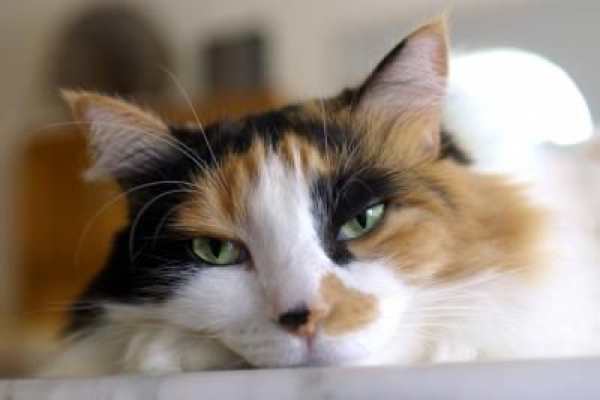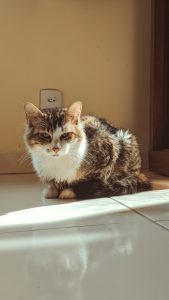Pancreatitis
Kitty’s Feeling Poorly. Is it Pancreatitis?
By Margie Scherk DVM, Dipl ABVP (Feline) Vancouver, Canada

Tabitha has been feeling poorly for the past five days. Her appetite is decreased and she is lethargic. Other than that, there is nothing that Mary, Tabitha’s person, can tell the vet. “She just seems off. But she isn’t vomiting or having diarrhoea. In fact, if anything, her stools seem smaller and firmer than usual. She had a bout like this about two months ago that lasted a few days but then she got better on her own. This time she seems a bit worse, so I thought you should see her.”
On examination, Tabitha, a six-year old spayed moggie, has lost a little weight and is mildly dehydrated. She doesn’t seem to be in pain anywhere, just seems to be feeling ill. The vet decides to run some tests including in her/his list of possible causes, pancreatitis.

Tabitha: “feeling ill”
But what is pancreatitis? By definition, pancreatitis means inflammation of the pancreas. The term doesn’t actually tell us more than that: it doesn’t indicate aetiology (cause), how the organ is affected, nor what outcome to expect. This makes it rather it a rather nebulous diagnosis that is made frequently. How common is it really?
Let’s take a step back. The pancreas plays important roles. It makes enzymes required for digestion and insulin to allow glucose derived from digestion to be used by cells for energy. There are numerous causes for inflammation of this organ as it is very sensitive to stress, metabolic derangements, or inadequate oxygen (due to poor blood flow), trauma, infectious agents, and potentially drugs, (as recognized in human pancreatitis). In the majority of cases (90%), the aetiology is unknown so it is termed “idiopathic”.
When should we consider pancreatitis? How do we diagnose Tabitha’s problem?
A history of lethargy, anorexia, dehydration, hypothermia (low temperature), vomiting (< 67% of cats), and less commonly, abdominal pain, abnormalities in breathing, diarrhoea and ataxia (lack of muscle coordination). These are non-specific findings that are not indicative of a particular disease or condition. Additionally, cats found to have pancreatitis on post mortem also had other conditions affecting the liver (hepatic lipidosis, cholangitis), bowel (inflammatory bowel disease (IBD), enteritis), or diabetes mellitus. Thus, a diagnosis requires a combination of clinical suspicion, specific abdominal ultrasound findings, and elevated feline pancreatic lipase immunoreactivity (fPLI) or DGGR lipase test results.
How do we make a diagnosis of pancreatitis (or other problems)?
After taking a really good history and examining Tabitha thoroughly, what tests might your vet request? Let’s look a bit closer at the diagnostic tests used. For any sick cat, a “minimum data base” should be collected. This basic (Tier 1 level) consists of blood tests (a complete blood count [CBC], biochemistries), a urinalysis and, if not performed as part of the examination already, a blood pressure measurement. This helps to rule in and rule out other conditions. Like fishing, you have a better chance of catching fish – making a diagnosis – when you throw a net. If you are after a specific type of fish you cast a rod. (I hope this analogy works – I don’t fish!) Running specific tests (Tier 2) like an ultrasound or fine-tuning with other tests such as fPLI or DGGR-lipase can muddy the waters without knowing what else is going on.

Ultrasound
It is important to understand that there are no perfect tests. There is a gold standard to which other tests are compared. In the case of pancreatitis, that is microscopic (histological) evaluation of pancreatic tissue samples (surgical or post mortem). The sensitivity (how often does it detect what you are testing for) and the specificity (how well does it pick up what you are testing for) of a test cannot both be 100%. In fact, they are inversely proportional. The more times a test detects something (sensitivity), the greater the chance of incorrectly detecting other things as well (hence, false positives); the more specific a test is, the greater the chance of it missing some (hence, false negatives). Even with the gold standard, there are questions as to what the degree of change (infiltration with inflammatory cells) exceeds normal wear-and-tear of day-to-day life. When we look at blood tests currently available, the fPLI is sensitive in cats with moderate-severe acute pancreatitis but not useful in cats with milder chronic disease. (There is a partner test, a SNAP fPL that can be run directly in the veterinary clinic that is even less useful.) Additionally, other diseases can impact the fPLI value: diabetes and IBD. So what about lipase? Lipase has been run for many years. Its value lies in that when elevated the patient probably has pancreatitis, but when normal, we cannot discount that possibility (falsely negative). A specific type of lipase assay, DGGR lipase run by some laboratories, is better and is essentially comparable to fPLI.
Abdominal ultrasound is sensitive in cats with moderate-severe pancreatitis showing swelling and changes in density with/without fluid around the pancreas, but it too can look normal in the face of pancreatitis.
A useful adjunctive test is cobalamin. This test measure Vitamin B12 levels which can be subnormal whenever the pancreas is affected, or the small intestine, or both. When it is low, kitty will benefit from treatment with Vitamin B12.
If you are completely confused by now but still reading this, you are not alone. Making a diagnosis of pancreatitis is difficult! Simply using a test result for fPLI or DGGR lipase or ultrasound is not enough. These tests need to be considered together and alongside clinical signs, history, physical exam findings, as well as the subjective clues that your veterinarian detects.
What about treatment for pancreatitis? I want to do something to help Tabitha!
Without having tissue samples (or even cytology – cells acquired using ultrasound guidance), it is not possible to know the cause of the pancreatitis even if Tabitha has an elevated fPLI or other changes. With a rather large grain of salt, based on her nondescript clinical signs and an elevated fPLI, she might have acute pancreatitis. Acute pancreatitis is treated with pain relief as cats are notoriously good at hiding pain. Drugs to stop nausea (with or without vomiting) are essential to eliminate that cause for having a poor appetite. Fluid therapy is critical to improve hydration and blood flow to the pancreas (and other tissues) and to correct any electrolyte abnormalities. Making sure that she gets enough calories from a good quality diet is essential for improvement. Your vet may recommend a diet that is “highly digestible” or a “hypoallergenic” diet.
However, the history gives a bit of a clue in that she had similar, albeit nonspecific, signs a few months ago so this might be chronic pancreatitis. If that were the case, then in addition to the treatments mentioned for acute pancreatitis, prednisolone might be warranted. And in both cases, cobalamin supplementation would be helpful.
Antibiotics are not needed routinely and should not be used without strong evidence for need and knowing which drug the bacteria are sensitive to. Antibiotics may actually upset the patient’s intestinal tract microflora making her feel worse. Secondly, overuse of antibiotics is encouraging bacteria to become resistant to them which is a very serious problem for the health of all species.
What does the future hold for Tabitha?
If she actually has acute pancreatitis, treatment supporting her basic needs: pain relief, anti-nausea drugs, nutrition, fluid therapy, should support her recovery. With chronic pancreatitis, along with the same initial treatment, she will need to stay on prednisolone long term to prevent scarring and reduced function of her pancreas. There are other types of pancreatitis (e.g., cancer, exocrine pancreatic insufficiency) that sadly don’t have as good of a prognosis or chance for resolution.

Possibly Pancreatitis
Cautionary comments
We do not know whether Tabitha has pancreatitis. Lots of other conditions mimic pancreatitis. But the good news is that for almost every condition a cat gets, treatment should include four things:
- Pain relief – assume a cat is hiding pain;
- Nutrition – including use of drugs to reduce nausea and stop vomiting as indicated;
- Fluid therapy to correct dehydration and electrolyte abnormalities and to maintain hydration;
- Meeting behavioural needs by making sure the environment allows the cat to express species-specific behaviours – their “catness”.
Key points:
- Cats do hide their signs of illness, therefore if you think something is wrong, trust your instinct and take your cat to see their doctor.
- Making a diagnosis requires more than testing but testing is part of the process.
- The four keys to treatment that should be considered regardless of disease are: analgesia, nutrition, hydration, and meeting behavioural needs.
- Despite this, investigative testing is of value to make as definitive a diagnosis as possible and to rule out other concurrent problems.
Feline Ailments
"Cats are a mysterious kind of folk"
Sir Walter Scott

 menu
menu